Printable Version of Topic
Click here to view this topic in its original format
914World.com _ 914World Garage _ Are head and cylinder gaskets compression gaskets?
Posted by: stevegm Oct 22 2016, 01:04 PM
I need to remove the heads off of a newly rebuilt engine (4-cylinder) I built (never run). They have already been torqued. Are the head gaskets and gasket between the cylinder and block, compression gaskets that should be thrown away (i.e., replaced with new one) after I untorque the heads?
The head gaskets will be easy to replace. But I'd have to pull the cylinders to replace the ones between them and the block.
Posted by: injunmort Oct 22 2016, 01:11 PM
i would not disturb the base gaskets and you can anneal head gaskets and reuse.
Posted by: N_Jay Oct 22 2016, 02:47 PM
The bottom are shims and should not compress.
The head sealing rings are designed to compress as and need to be replaced.
If you are cheap you can anneal them and hope for the best. They will return to there press installed softness but not shape.
Posted by: stugray Oct 22 2016, 04:56 PM
Bigger question: WHY are you using head gaskets?
Posted by: HAM Inc Oct 22 2016, 05:24 PM
i would not disturb the base gaskets and you can anneal head gaskets and reuse.
I think he's talking about head gaskets, not copper ex. gaskets. Copper ex gaskets you can anneal. Unless he's switched to an aftermarket copper head gasket the head gaskets are laminated aluminum. Never heard of anyone annealing them.
They should not be used in the first place.
But if you do choose not to use the gaskets, you increase your compression ratio if you don't put equally thick barrel spacers under the jugs.
You also reduce your deck ht by the thickness of the gaskets, which new is ~.75mm.
If you have 1mm or more deck ht in your cylinders and you are happy with the bump in comression then no need for barrel spacers.
If the engine was never run you should be able to retorque the gaskets if you want to reuse them. I would try to put them back in the same positions, though.
Posted by: ClayPerrine Oct 22 2016, 05:33 PM
Bigger question: WHY are you using head gaskets?
They should not be used in the first place.
The VW tech bulletin everyone seems to refer to when this subject comes up does not apply to the 914 motors. People like Jake Raby have a machine shop that can make the cylinders fit into the heads perfectly, thus making sure they seal correctly. I don't have that ability, and the factory engineers designed them into the motor. And I suspect that those German Engineers are a lot smarter than any of us (Including Jake) when it comes to these motors. So I use them in every engine I build. And I don't have any problems with them blowing out.
And you won't notice the gain more HP by increasing the compression .01%.
Posted by: Dave_Darling Oct 22 2016, 05:33 PM
At one point, at least, there were also copper head gaskets/sealing rings that were available for the VW Type IV engine. They did compress, and required you to periodically re-torque the heads. They were not favorably viewed by a lot of people for that reason--it's a PITA to re-torque the heads on the Type IV engine while installed in our cars!!
--DD
Posted by: stevegm Oct 22 2016, 08:26 PM
Bigger question: WHY are you using head gaskets?
They should not be used in the first place.
The VW tech bulletin everyone seems to refer to when this subject comes up does not apply to the 914 motors. People like Jake Raby have a machine shop that can make the cylinders fit into the heads perfectly, thus making sure they seal correctly. I don't have that ability, and the factory engineers designed them into the motor. And I suspect that those German Engineers are a lot smarter than any of us (Including Jake) when it comes to these motors. So I use them in every engine I build. And I don't have any problems with them blowing out.
And you won't notice the gain more HP by increasing the compression .01%.
My thoughts exactly. I will change the head gaskets just to be safe. I just didn't feel like taking the cylinders back off to change the base gaskets. They are out of the Victor Reinz gasket set. I was hoping someone might know if they are compression or not.
Posted by: HAM Inc Oct 22 2016, 08:33 PM
Bigger question: WHY are you using head gaskets?
They should not be used in the first place.
The VW tech bulletin everyone seems to refer to when this subject comes up does not apply to the 914 motors. People like Jake Raby have a machine shop that can make the cylinders fit into the heads perfectly, thus making sure they seal correctly. I don't have that ability, and the factory engineers designed them into the motor. And I suspect that those German Engineers are a lot smarter than any of us (Including Jake) when it comes to these motors. So I use them in every engine I build. And I don't have any problems with them blowing out.
And you won't notice the gain more HP by increasing the compression .01%.
My thoughts exactly. I will change the head gaskets just to be safe. I just didn't feel like taking the cylinders back off to change the base gaskets. They are out of the Victor Reinz gasket set. I was hoping someone might know if they are compression or not.
The base gaskets will be fine.
Posted by: Keyser Sose Oct 23 2016, 11:26 AM
The VW tech bulletin everyone seems to refer to when this subject comes up does not apply to the 914 motors. People like Jake Raby have a machine shop that can make the cylinders fit into the heads perfectly, thus making sure they seal correctly. I don't have that ability, and the factory engineers designed them into the motor. And I suspect that those German Engineers are a lot smarter than any of us (Including Jake) when it comes to these motors. So I use them in every engine I build. And I don't have any problems with them blowing out.
And you won't notice the gain more HP by increasing the compression .01%.
Clay, it may be in a Porsche car but it's still a VW engine. The 1.7 and 1.8 heads and cylinders are identical but even the 2.0 heads, tweaked a bit by Porsche, didn't change the head to cylinder sealing surfaces, shape, dimensions or torque. It's still all VW. And the VW bulletin wasn't factory, it was addressed to rebuilders, so in the same situation that we are.
That being said unless I was that engine's builder and knew the clearances I'd just replace the head gaskets and put it back together the way it was rather than risking too tight deck height.
Posted by: injunmort Oct 23 2016, 04:02 PM
i know which gaskets op was referring to. mine are copper and reused them with no issue. as stated earlier, the people who designed the engine thought enough to include them, so i do too. mine dont leak and i sincerely doubt there is any performance to be gained by omitting them. the only only aircooled engines i have seen that run without a headgasket are english 500cc engines of the 1930's. they had a cast in spigot or "firewall" to seal them, but heads had to be lapped in like a valve. also, headbolts are supposed to be retorqued after heat cycling a few times anyway, i dont see that copper gaskets are in anyway inferior to the steel gaskets in the retorqueing area.
Posted by: Jake Raby Oct 23 2016, 10:05 PM
The last time I used any gaskets between the cylinder, and the head was in 1995. One more thing to fail, and I never trust 3 pieces of .007" aluminum formed together to hold cylinder pressures.
The gasket thats not there, can't fail.
Posted by: stugray Oct 23 2016, 10:17 PM
i know which gaskets op was referring to. mine are copper and reused them with no issue. as stated earlier, the people who designed the engine thought enough to include them, so i do too.
The engineers of the Galaxy Note 7 thought it a good idea to include a 3500 mAh Li-Ion battery to a 8mm thick phone too.
Is that somehow evidence that they are infallible?
Posted by: injunmort Oct 24 2016, 03:05 AM
one generation of that phone, not ten years of production, so yeah in this case, as opposed to the phone.
Posted by: N_Jay Oct 24 2016, 07:32 AM
For those in the "No Gasket" world, do you lap the cylinder barrels to the heads?
Posted by: stugray Oct 24 2016, 08:16 AM
one generation of that phone, not ten years of production, so yeah in this case, as opposed to the phone.
You must have also missed where two of the most knowledgeable type IV engine experts (possibly in the world) just said (above) that you should not use gaskets.
Posted by: injunmort Oct 24 2016, 08:53 AM
yeah i saw that, i also see the manual, haynes, vw/porsche say to use them. they have come each engine gasket kit i have gotten from renz. the world famous engine builders dont say how they prep head or cylinders. so i am going with the engineer who designed the engine and use the gaskets in my stock street applications on my cars.
Posted by: Keyser Sose Oct 24 2016, 10:09 AM
Cool, but I wouldn't depend on Haynes as gospel, and if you're going to defer to the engineer who designed the engine then you need to eliminate those gaskets. Here, the last word from VW on that subject:
http://www.ratwell.com/mirror/www.dolphinsci.com/techbull.html
My own experience is that the failure rate is very small, maybe a percent or two and after a lot of miles, but those are still failures and there's no need for it. I know some builders still use gaskets, so it's not certain death or anything, and of course you can do anything you want with your own engines.
Posted by: ClayPerrine Oct 24 2016, 09:22 PM
Cool, but I wouldn't depend on Haynes as gospel, and if you're going to defer to the engineer who designed the engine then you need to eliminate those gaskets. Here, the last word from VW on that subject:
http://www.ratwell.com/mirror/www.dolphinsci.com/techbull.html
My own experience is that the failure rate is very small, maybe a percent or two and after a lot of miles, but those are still failures and there's no need for it. I know some builders still use gaskets, so it's not certain death or anything, and of course you can do anything you want with your own engines.
The tech bulletin specifically calls out
"Models(s): Type II/Vanagon 1975 - 83 MY Date: May 31, 1990"
I don't see Type IV anywhere in the listing, much less the 914.
Posted by: stugray Oct 25 2016, 07:13 AM
Cool, but I wouldn't depend on Haynes as gospel, and if you're going to defer to the engineer who designed the engine then you need to eliminate those gaskets. Here, the last word from VW on that subject:
http://www.ratwell.com/mirror/www.dolphinsci.com/techbull.html
My own experience is that the failure rate is very small, maybe a percent or two and after a lot of miles, but those are still failures and there's no need for it. I know some builders still use gaskets, so it's not certain death or anything, and of course you can do anything you want with your own engines.
The tech bulletin specifically calls out
"Models(s): Type II/Vanagon 1975 - 83 MY Date: May 31, 1990"
I don't see Type IV anywhere in the listing, much less the 914.
you DO realize that the engine is exactly the same (with respect to the head sealing interface) as the 914 don't you?
Posted by: Mark Henry Oct 25 2016, 08:28 AM
If you want head gaskets in one of my T4 engines find another engine builder. ![]()
I hear GEX offer good prices.... ![]()
Posted by: ClayPerrine Oct 25 2016, 09:09 AM
If you want head gaskets in one of my T4 engines find another engine builder.
I hear GEX offer good prices....
You are the one who builds the motor. You have to stand behind your work. So do what you feel is right.
I will do the same.
Posted by: stevegm Oct 25 2016, 09:46 AM
I didn't mean to invite a debate. This issue has been widely discussed. Everybody can make their own decisions for their engines. For me, I will use a head gasket on a street engine. And I will suffer the consequences if it blows out. I was just curious if the head gasket, and base basket, are compression-style gaskets, needing to be replaced after untorquing.
Posted by: Mark Henry Oct 25 2016, 09:52 AM
New T4 AMC heads come with a big warning card in every box "Do Not use head gaskets".
BTW I just tossed out a couple dozen new head gasket sets. ![]()
Posted by: Jake Raby Oct 25 2016, 09:00 PM
You can lead a human to knowledge, but you can't make them think.
Posted by: The Cabinetmaker Oct 25 2016, 09:24 PM
Words to ponder
Posted by: mbseto Oct 26 2016, 08:34 AM
You can lead a human to knowledge, but you can't make them think.
No one's led us to knowledge yet, they've just said 'do what I say'. I was hoping someone might address that question of whether the head and cylinders need to be lapped together. Can I do it by hand? Depending on the tools required, gaskets might be the option I can afford.
Posted by: injunmort Oct 26 2016, 08:57 AM
^well said. my experience would lead me to lap the cylinders into the head with grinding paste to get a uniform surface. on a 1930's norton 500 single, easy to do without upsetting the cylinders and rings. on a type IV, not so much as you would have to remove cylinders and lap them into the head to get a uniform surface. i use the gasket because it is easier to get a tight mating surface without disturbing the ringland. on a blueprinted, heavily modified engine with lots of aftermarket components and custom machine work, i can see it. a stock street motor not so much.
Posted by: HAM Inc Oct 26 2016, 09:33 AM
The reason VW said to stop using the head gaskets is, the differences in expansion rates of the bi-metal relationship between the heads and jugs combined with the inevitable shuffling (relative movement between the heads and jugs) during operation causes the laminated aluminum gaskets to delaminate. That buletin was not written with performance engines in mind, but stock.
Once they start delaminating, they allow combustion gasses to escape, which quickly etches a big path that very often leads to serious damage to the head.
Here's the reality about lapping jugs into heads: If the finish in the heads from the flycutting is rough the lapping will smooth it, but if the surface is so rough that it needs that then how much confidence do you have in the machine works accuracy with regard to both chambers being the same height AND on the same plane. Also, lapping will remove metal from the heads, but do little if anything to ensure the jugs are flat.
If you choose to lap, make a paste out of ajax and count your revolutions so you can use the same technique on each postion. If a light lap doesn't clean up the both surfaces, time for a trip to the machine shop.
Many engine builders toss the gaskets and spray the heads with aerosol coppercoat a few minutes before assembly. Overspray will not hurt anything.
That's the low down on gaskets. Proceed with your engines as you wish.
Posted by: Mueller Oct 26 2016, 09:55 AM
Head gaskets installed on my current torn apart motor, pics below show deformation of gaskets and damage to head. Pro built motor, not a lot of miles based on how clean the motor was inside and outside under the tin.
(had a flat cam, the reason for the teardown)
Top pic shows one gasket that has deformed.
Other pictures show head damage, luckily caught before gasket failed completely allowing gases to escape and burning small ridges into head as they leave.
I will now have to make a flycutter to fix the head. 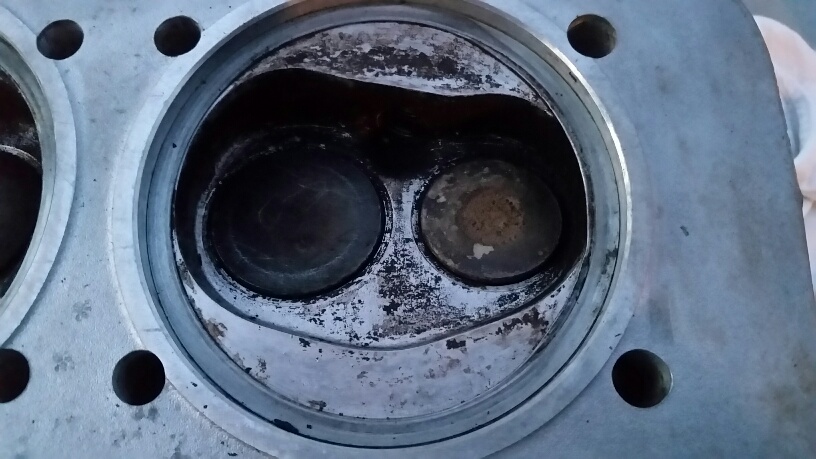
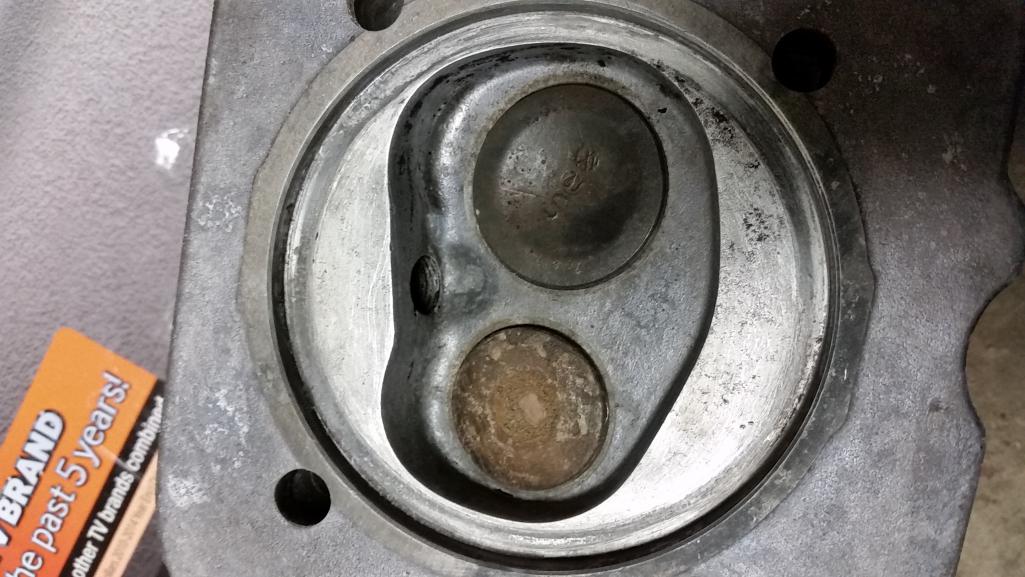
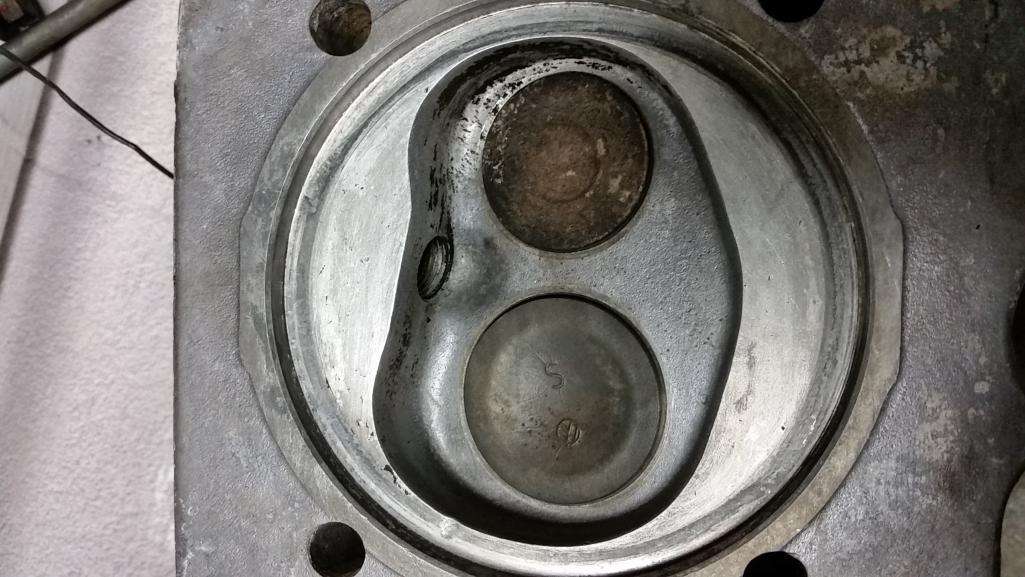
Posted by: injunmort Oct 26 2016, 10:09 AM
i could be wrong but what i see is a deformed gasket from improper torquing sequence, not a gasket failure. looks like one side was over tightened causing the gasket to deform. you can see the result.
Posted by: rudedude Oct 26 2016, 11:05 AM
pretty good eyes to see improper torque
Posted by: HAM Inc Oct 26 2016, 11:20 AM
i could be wrong but what i see is a deformed gasket from improper torquing sequence, not a gasket failure. looks like one side was over tightened causing the gasket to deform. you can see the result.
Look pal, DIY's come here for advise. There are a host of professionals in various specific fields that apply directly to some of these questions who help our fellow 914 lovers.
In this particular case the O.P.'s question related to a very specific apect of an engine build. This issue was addressed by VW 40 years ago. It's actually settled technology.
And as if that weren't enough, at least 3 engine professionals - myself included -with well over 50 years of combined T4 engine experience chimed in to help advise the O.P.
I have no problem with your disagreeing with me. I really don't care. But you do a diservice to the O.P. and others tryiing to learn when you argue from a position of ignorance.
You've done this on other threads as well and have exhibited the kind of behavior that contributes to the spread of misinformation that the internet has, sadly, become famous for.
I know a lot of professional aircooled VW engine builders, and not a single one of them uses head gaskets on a typical build. Are you the one professional exception, or just an internet troll? That's a rhetorical question. Based on your technical postitions, I already know the answer.
Posted by: stevegm Oct 26 2016, 11:57 AM
![]()
So, it sounds like I need to consider not using head gaskets. I researched this some time ago, but, it seems that the consensus here is not to use them. Maybe somebody could post the process that needs to be performed to leave them out? Can this be done by a "garage mechanic" like myself? ![]()
Posted by: injunmort Oct 26 2016, 01:20 PM
i do use the gaskets, i think you mean aircooled vw engine builders, sorry i dont worship at your altar, that does seem to bother you and i aint your pal.
Posted by: ClayPerrine Oct 26 2016, 01:33 PM
There seems to be a difference of opinion here and it is not going to be solved over the internet.
Do what you think is right, and I will do what I think is right.
![]()
![]()
![]()
![]()
Posted by: Mark Henry Oct 26 2016, 01:44 PM
My lapping procedure is actually quite simple.
I use valve grinding compound, not because I think it's the best, but because I have a huge can of it that was given to me. I put an even coat on the sealing surface of the cylinder, place it in the head and turn it a couple times (no pressure)complete turns, then check to see that I have an even coat.
I then turn it so it facing the direction it will be installed. I grab it with both hands and rotate back and forth the limits of my wrists, I put slight downward pressure to make sure the head doesn't lift or cock in the bore.
As I start I look at the clock, I keep a steady cadence and I do the same amount of time on each cylinder. The amount of time will depend on your compound, mine is fairly aggressive and I only have to do 1-2 minutes each bore. Once I have a clear, even lap it's done.
I mark every cylinder and bore so they stay in order, very important.
Cleaning has to be spotless, again very important.
If you are doing a real good job you should also have your case bores surfaced/decked, I do this as a part of every build now, as I find many are out of spec.
The last detail is do a freaking CR check, (plus deck height) and shim it for a correct CR.
Google engine calculator and plug in the numbers, I can do the math, I don't need a calculator.
Head CC you can buy the plate kit or make one out of 1/4" clear plexi, you can get a CC syringe from a drugstore, just tell them what you want it for, tell them you don't want the needle and you want the biggest they have. PITA because 10cc is likely the biggest they have, but in a pinch it works. Just don't lose count. Oil will kill the rubber stopper, you can use water, but put a drop of Dawn dish soap in it to break the surface tension.
You can get custom shims made by RIMCO and EMW keeps a stock of shims. You can use up to 3 of the thin factory shims but no more. They must be shimed exactly the same.
That's it, I've never seen the need to go full rotations. Many years ago I talked to a swiss trained master machinist friend about my procedure and he agreed with it, BTW same guy who gave me the big can of lapping compound.
My heads never leak, at least not till it's time that they should be rebuilt anyways.
Been doing it this way for years.
Posted by: N_Jay Oct 26 2016, 01:59 PM
So, it sounds like I need to consider not using head gaskets. I researched this some time ago, but, it seems that the consensus here is not to use them. Maybe somebody could post the process that needs to be performed to leave them out? Can this be done by a "garage mechanic" like myself?
For those of us watching from the side lines, I think this captures the question.
If you buy a typical set of cylinders and don't have access to have the top surface re-machined, and you heads are freshly done by a competent (but probably not a specialist) machine shop, are you more or less likely to have issues with or without head gaskets.
And if you are leaving the head gaskets out, do you have any additional prep required??
To roll all the way back to the OP, if his engine was built with head gaskets, what is the chance he can reseat the heads without them?
How much risk is there due to the slight increase in compression and/or the slight decrease in effective deck height?
Posted by: stevegm Oct 26 2016, 02:10 PM
Exactly. Leaving them out is not as simple as . . . well, just leaving them out. And the proper process needed to leave them out is beyond the scope of my expertise and tools, in this area. I have built quite a few street engines over the years, always put them in, and never had a problem. Also, as I understand it, most of the problems that have arisen using them, have occurred after quite some miles (tens of thousands). Most of us aren't putting that many miles on our 914s these days, unless it is a daily driver.
Having said that, there seems to be a large enough of a concensus that they should be left out to cause me to want to reconsider my traditional choice. I respect the learned engine builders here, and certainly want to benefit from their expertise.
Posted by: stugray Oct 26 2016, 02:42 PM
Head CC you can buy the plate kit or make one out of 1/4" clear plexi, you can get a CC syringe from a drugstore, just tell them what you want it for, tell them you don't want the needle and you want the biggest they have. PITA because 10cc is likely the biggest they have, but in a pinch it works.
I found one at a farm supply in the "veterinary/medicine" department.
It was ....wait for it...... 60ccs.
In my area the store is Murdoch's I don't know what you have in the GWN.
Posted by: N_Jay Oct 26 2016, 02:51 PM
Vets will have larger syringes as they get used for hand feeding small animals.
Posted by: Mark Henry Oct 26 2016, 02:57 PM
I've never had to find one, wife works at a hospital. ![]()
Posted by: Mueller Oct 26 2016, 03:45 PM
i could be wrong but what i see is a deformed gasket from improper torquing sequence, not a gasket failure. looks like one side was over tightened causing the gasket to deform. you can see the result.
I thought that too, however that deformed part is on the hotter exhaust side.
I'll see if I have the pictures of the other gaskets.
Posted by: injunmort Oct 26 2016, 04:51 PM
^that makes sense to me, in that the the exhaust side runs much hotter, (hence, the the sodium filled exhaust valves or nmeumonic exhaust valves, to disisapate heat more efficiently reside.) if the deformation was in that area, the exhaust stroke will reek the havok you see by a faulty seal. but iam sure HAM,INC, has a well reasoned explanation as to why i am full of shit and you need a set of new $2,000.00 heads.
6
Posted by: Mark Henry Oct 27 2016, 07:42 AM
^that makes sense to me, in that the the exhaust side runs much hotter, (hence, the the sodium filled exhaust valves or nmeumonic exhaust valves, to disisapate heat more efficiently reside.) if the deformation was in that area, the exhaust stroke will reek the havok you see by a faulty seal. but iam sure HAM,INC, has a well reasoned explanation as to why i am full of shit and you need a set of new $2,000.00 heads.
6
You're a special kind of stupid aren't you.
Would you like me to count the the number mistakes and misinformation you've made in this thread alone?
Because bud you've made plenty.
You are nowhere near an expert on this subject, in fact you're a piss poor amateur.
"nmeumonic exhaust valves" What? Are you saying nmeumonic is a material?
Posted by: N_Jay Oct 27 2016, 08:33 AM
Thoughts!
Lapping barrels to heads:
Since the materials are significantly different in resistance to abrasion (what lapping is doing) most all the wear (lapping, polishing) will be on the softer material of the head.
Lapping valve makes sense because the materials are of similar hardness, and they rotate in operation so you ant a surface the seals at any position in the rotation.
So lets take three different assumptions.
1) Machine marks in the sealing surface of the barrel are concentric.
Lapping the head slightly polishes the barrel, while shaping the matting surface to match these concentric marks. - Yielding an
improved seal.
2) Machine marks are not concentric; perpendicular, axial, or even random.
Lapping the head polishes the mating surface to near flat (average of random barrel surface), and slightly polishes the barrel, yielding a slightly improved seal.
3) Machine marks are radial or spiral but not concentric;
Lapping again polishes the head to near flat depending on the degrees of rotation. Example, machining with a slow spiral pattern and a relatively small rotation (less than 1/4) would actually cut matching groves into the head. In this case the seal is only improved if the head and barrel are assembled near the mid point of the lapping rotational arc.
(Not arguing, just thinking)
Obviously gaskets have their own issues, especially with the high temperatures and relative motion (Difference's in expansion, of heads barrels and studs, etc.)
I wonder what would happen if you machined a slight grove into the top of the barrel (decreasing the surface area and therefore increasing the contact force) and use a o-ring shaped deformable gasket to make a secondary seal?
Posted by: Mark Henry Oct 27 2016, 08:55 AM
I wonder what would happen if you machined a slight grove into the top of the barrel (decreasing the surface area and therefore increasing the contact force) and use a o-ring shaped deformable gasket to make a secondary seal?
Porsche totally deleted the head gasket/ring by the 3.2...
Must be their worst engine.
Posted by: mbseto Oct 27 2016, 09:05 AM
Mark, thanks for that procedure above, that's what I was hoping for.
Posted by: N_Jay Oct 27 2016, 09:06 AM
I wonder what would happen if you machined a slight grove into the top of the barrel (decreasing the surface area and therefore increasing the contact force) and use a o-ring shaped deformable gasket to make a secondary seal?
Porsche totally deleted the head gasket/ring by the 3.2...
Must be their worst engine.
You seem to miss the point that "designing in" or "designing out" a head gasket is a DESIGN issue.
Machining, materials, and assembly specifications all come into play.
EDIT:
This takes me back to working in a chemistry analytics lab at school.
We had machines that needed very high and very low pressure seals at very high and very low temperatures.
Most common seal was two machined flat surfaces and a gold wire as an o-ring. (That, and lots of bolts for even tension.)
Some has a grove for the wire, some did not. (all specified a real gold wire o-ring, but the school was cheaping out.)
Posted by: Mueller Oct 27 2016, 09:36 AM
Picture "borrowed" from brand new post on the 914 Facebook page.
Gasket failure, 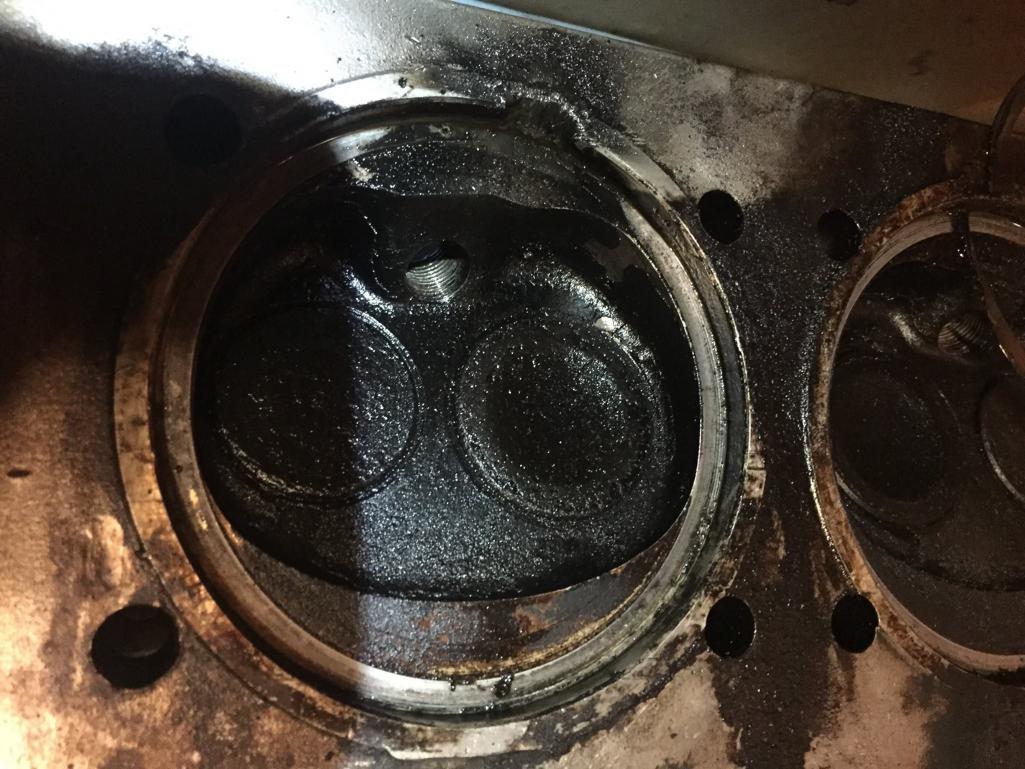
Posted by: Mueller Oct 27 2016, 09:40 AM
I've never had to find one, wife works at a hospital.
The real question is are they empty when they come home?
Posted by: Mueller Oct 27 2016, 09:41 AM
I've never had to find one, wife works at a hospital.
The real question is are they empty when they come home?
Posted by: Mark Henry Oct 27 2016, 10:08 AM
I wonder what would happen if you machined a slight grove into the top of the barrel (decreasing the surface area and therefore increasing the contact force) and use a o-ring shaped deformable gasket to make a secondary seal?
Porsche totally deleted the head gasket/ring by the 3.2...
Must be their worst engine.
You seem to miss the point that "designing in" or "designing out" a head gasket is a DESIGN issue.
Machining, materials, and assembly specifications all come into play.
EDIT:
This takes me back to working in a chemistry analytics lab at school.
We had machines that needed very high and very low pressure seals at very high and very low temperatures.
Most common seal was two machined flat surfaces and a gold wire as an o-ring. (That, and lots of bolts for even tension.)
Some has a grove for the wire, some did not. (all specified a real gold wire o-ring, but the school was cheaping out.)
I'm done, you guys know way more than us unedumacated grunts will ever know.
Posted by: ClayPerrine Oct 27 2016, 10:58 AM
I wonder what would happen if you machined a slight grove into the top of the barrel (decreasing the surface area and therefore increasing the contact force) and use a o-ring shaped deformable gasket to make a secondary seal?
Porsche totally deleted the head gasket/ring by the 3.2...
Must be their worst engine.
And Porsche put them back in on the 3.6L engines after finding significant failures.
Cylinder Leakage
The first generation of 3.6 litre engines from 1990 to early 1992 didn’t use a head gasket which caused some leakage to be observed from between the heads and the top of the cylinders. In most cases, this was simply a small seepage of oil which looked far worse than it really was. Porsche solved the problem by installing sealing rings in early 1992 to prevent serious leaks and the rest of the 964 and 993 engines all had gaskets.
For owners of these early 964’s without gaskets who have some leaking issues, we can fix this problem by machining the heads for sealing rings and modifying the top of these early cylinders to fit and seal better.
Reference : http://rennsportsystems.com/3-6-engines/
Posted by: N_Jay Oct 27 2016, 11:17 AM
I wonder what would happen if you machined a slight grove into the top of the barrel (decreasing the surface area and therefore increasing the contact force) and use a o-ring shaped deformable gasket to make a secondary seal?
Porsche totally deleted the head gasket/ring by the 3.2...
Must be their worst engine.
And Porsche put them back in on the 3.6L engines after finding significant failures.
Cylinder Leakage
The first generation of 3.6 litre engines from 1990 to early 1992 didn’t use a head gasket which caused some leakage to be observed from between the heads and the top of the cylinders. In most cases, this was simply a small seepage of oil which looked far worse than it really was. Porsche solved the problem by installing sealing rings in early 1992 to prevent serious leaks and the rest of the 964 and 993 engines all had gaskets.
For owners of these early 964’s without gaskets who have some leaking issues, we can fix this problem by machining the heads for sealing rings and modifying the top of these early cylinders to fit and seal better.
Reference : http://rennsportsystems.com/3-6-engines/
Oh, now you made him mad.
Based on his avatar, he my go hulk on us.
Just razzing.
Guess this, and the comments about the differences to add sealing rings/gaskets, you can start seeing the design-in vs. design-out issues.
Posted by: injunmort Oct 27 2016, 05:11 PM
you guys know what i did today, i went for a drive in my special kind of stupid, the one with head gaskets. kimbo, refer to your responses to the capt n back in 2014. also, try some prussian blue after your lapping clean up. no guessing on seal then. what have i learned from this, there is more to "dont use head gaskets" it took kimbo three pages of post to even go into lapping cylinders, an adequate tutorial, yet so incomplete. how do you make sure you have uniform mating surfaces? at least he did go into a lapping procedure. HAM,INC, not so much. i have never met a "professional engine builder, that will reveal their proccess, i dont blame them, it is proprietary info, but i have trouble with "dont use headgaskets because i dont" because there is far more to it than that. enough said, now flame me douche bag.
Posted by: Dave_Darling Oct 27 2016, 05:15 PM
Picture "borrowed" from brand new post on the 914 Facebook page.
Gasket failure,
Yup, that is the absolutely typical gasket failure. As in, if/when the gasket fails, that is what happens. If you let it go even longer (just turn up the radio!) that eroded area turns into a deep channel.
I don't know if the head in the photo is junk yet or not, but if it were allowed to get much worse it definitely would be.
--DD
Posted by: Mueller Oct 27 2016, 05:23 PM
you guys know what i did today, i went for a drive in my special kind of stupid, the one with head gaskets. kimbo, refer to your responses to the capt n back in 2014. also, try some prussian blue after your lapping clean up. no guessing on seal then. what have i learned from this, there is more to "dont use head gaskets" it took kimbo three pages of post to even go into lapping cylinders, an adequate tutorial, yet so incomplete. how do you make sure you have uniform mating surfaces? at least he did go into a lapping procedure. HAM,INC, not so much. i have never met a "professional engine builder, that will reveal their proccess, i dont blame them, it is proprietary info, but i have trouble with "dont use headgaskets because i dont" because there is far more to it than that. enough said, now flame me douche bag.
The factory issued a service bulletin about not using them in the type IV.
Posted by: ClayPerrine Oct 27 2016, 05:26 PM
The factory issued a service bulletin about not using them in the type IV.
Already answered in an earlier post.
Bigger question: WHY are you using head gaskets?
They should not be used in the first place.
The VW tech bulletin everyone seems to refer to when this subject comes up does not apply to the 914 motors. People like Jake Raby have a machine shop that can make the cylinders fit into the heads perfectly, thus making sure they seal correctly. I don't have that ability, and the factory engineers designed them into the motor. And I suspect that those German Engineers are a lot smarter than any of us (Including Jake) when it comes to these motors. So I use them in every engine I build. And I don't have any problems with them blowing out.
And you won't notice the gain more HP by increasing the compression .01%.
Posted by: injunmort Oct 27 2016, 05:29 PM
i have seen it, it is part of this thread, but refering back to the capt n, that did not include the 914, only the bus engines as the head design was different. search head gaskets on this site, i think around march of 2014, kimbo and the capt n go into this, only a little more courteously than the current iteration of the type IV god. also, i think clay's response summs up the gist of the 2014 posts, but still worth the read.
Posted by: Mueller Oct 27 2016, 06:12 PM
you guys know what i did today, i went for a drive in my special kind of stupid, the one with head gaskets. kimbo, refer to your responses to the capt n back in 2014. also, try some prussian blue after your lapping clean up. no guessing on seal then. what have i learned from this, there is more to "dont use head gaskets" it took kimbo three pages of post to even go into lapping cylinders, an adequate tutorial, yet so incomplete. how do you make sure you have uniform mating surfaces? at least he did go into a lapping procedure. HAM,INC, not so much. i have never met a "professional engine builder, that will reveal their proccess, i dont blame them, it is proprietary info, but i have trouble with "dont use headgaskets because i dont" because there is far more to it than that. enough said, now flame me douche bag.
Lapping by hand is not a secret or tightly controlled trick or procedure. A quick search shows how to lap, it is service books for assemblies that require it for proper fit of parts. It is not that special of a job that one must take an oath so as to not teach the wrong person.
It is proven the gaskets work, it is also proven no gaskets work (both stock and high performance applications)
Some people get stuck on the "factory only way of doing things" and refuse to deviate from that path.
Why knows, maybe if the 914 was still made in '77 or later the factory would have ditched the gaskets?
And you still want to have decent sealing surfaces on the head and the cylinder. The gasket is not a band-aid for poor workmanship or poorly finished parts.
Curious if the die hard pro-gasket crowd has changed their 914 in any way using non stock parts such as bigger sway bar or stiffer Springs?
If so how can they justify doing that since the factory didn't do it or say it was okay?
Posted by: ClayPerrine Oct 27 2016, 06:14 PM
It is proven the gaskets work, it is also proven no gaskets work (both stock and high performance applications)
Some people get stuck on the "factory only way of doing things" and refuse to deviate from that path.
Why knows, maybe if the 914 was still made in '77 or later the factory would have ditched the gaskets?
And you still want to have decent sealing surfaces on the head and the cylinder. The gasket is not a band-aid for poor workmanship or poorly finished parts.
If you are comfortable with the head gaskets, then use them. If you are not, then leave them out.
It is YOUR car. Do it the way YOU think is best.
Posted by: injunmort Oct 27 2016, 06:35 PM
^pretty much sums it up. i did not or any other pro gasket fan say "you must use the gasket" all i said was i do use the gasket without incident. i explained my reasoning as to why i do. the end. the burning bushes atacked because they dont. thats great. my point was you dont take the head gaskets off, throw the gaskets in the trash and then put the head back on, "because i dont use the gaskets." with out a little justification. am i asking too much? kimbo will will go batshit, but what do you think that breach would look like without the gasket? if it didnt seal upon reassembly, and his blow torch scenario just went from the combustion chamber to the breach rather the exhaust valve. the nmemonic sodium filled exhaust valve, ( i am a special kind of stupid) would be worse. see the 2014 thread on this and read the capt n.
Posted by: cuddyk Oct 27 2016, 07:35 PM
I think what's happening here is that some incredibly knowledgeable engine professionals devote their valuable time to help us shade tree guys. And when their learned advice is discounted, they become frustrated. I'm not a believer in flaming people, but I understand what drives them to it.
As far as the gasket "controversy" is concerned, it's pretty clear that the opinions of the manufacturer and experts have changed from "use" to "don't use". Much like our outlook on smoking cigarettes or eating lots of red meat. Not everyone gets sick from those things, but time has proven that they can be dangerous. Use at your own risk.
Posted by: injunmort Oct 27 2016, 07:50 PM
cuddyk , i would like to invite all ne guys to my man cave for a bbq. drive , tech day to my home before the season of our discontentment begins, your only 30 miles from me. maybe we get ray,paul rory. joe andy and kimbo slice from ontario, fuck the crackers. i am being insensitive?
Posted by: cuddyk Oct 27 2016, 08:19 PM
I'm always up for a drive and BBQ. And for respecting people even when they have differing opinions ![]()
Posted by: ClayPerrine Oct 27 2016, 08:42 PM
I think what's happening here is that some incredibly knowledgeable engine professionals devote their valuable time to help us shade tree guys. And when their learned advice is discounted, they become frustrated. I'm not a believer in flaming people, but I understand what drives them to it.
You need to check the background on both sides of the argument.
Clay Perrine
ASE Certified Master Automobile Technician (retired.. now in IT)
Over 30 years of 914 experience, including time with a Porsche specialist.
The Late John Larson (Cap'n Krusty)
Professional Porsche Mechanic.
Worked on 914s since they were new.
The Cap'n always used the head gaskets, and so do I.
But like I said before......
It's your car. Do what you think is the right thing.
Posted by: N_Jay Oct 27 2016, 09:37 PM
Sorry for jumping in, but I can tell you that in every field there are very experienced technicians that have developed myths on how their process is the "right way".
This is not saying that they are wrong (or right).
This is very different from designs and processes that are engineered.
We would all do better if we turned down the emotions and take the time to consider what is being asked and said.
Posted by: timothy_nd28 Oct 27 2016, 10:04 PM
My way is without question the best way. Lap the cylinder head gasket to both the head and the cylinder. Next, install the cylinder head gasket and properly torque the heads. Drive the car for 200 miles, then tear apart the engine to remove the gaskets. Reassemble engine without gaskets, then drive it like you stole it. ![]()
Posted by: KeithVonLaws Oct 28 2016, 12:10 AM
Well said to N_Jay...
One other thing that has been somewhat overlooked in this thread is the application.
Is this a stock rebuild or a performance application. Several methods
will WORK... The best way is the one that suits your build and possibly
gives you Peace of mind. I personally would accept either way with or without
gaskets based on the use of the Engine in question. I can say one thing and
that is the fact I would not use a gasket to seal an engine with 13:1
compression or one with a TURBO (you cant Turbo a Type IV Right). ![]()
I would like to see some of the cylinder sealing technology tried by some of the guys who have spent a lot of blood sweat and beers on Type IV Engines. I have some Ideas I am trying out myself in a high compression high RPM engine. I dont have any data or testing done yet but I will be pleased to post my success or failures on this subject. Its a shame we have to learn like this since Type IV engines have been around for nearly 50 years and Trade Secrets are still Tight Lipped.... ![]()
Posted by: Mark Henry Oct 28 2016, 12:49 AM
My personal engine, 102mm X 78mm, nickies with JE pistons.
Built the heads myself, 12mm plugs, 44mm X 38mm SS valves 8mm stems, new seats, dual springs , CrMo retainers, hardened keepers, shimmed, bit of exhaust porting 9mm X 8mm exhaust studs, bored to 103 register, 9.2 CR.
No head gaskets, nothing really trick about the sealing surface....
I have about 20K on the engine now, my summer DD.
Attached image(s)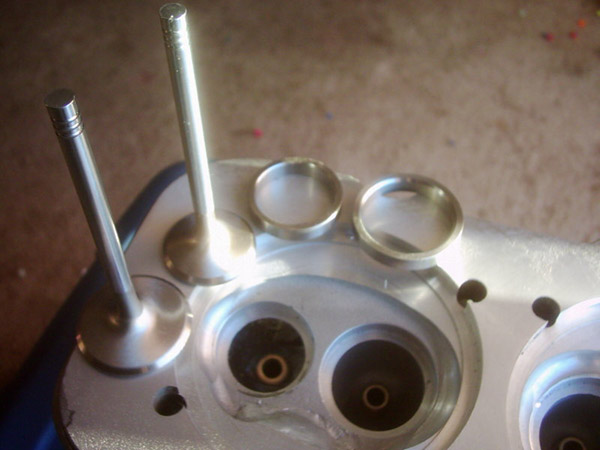
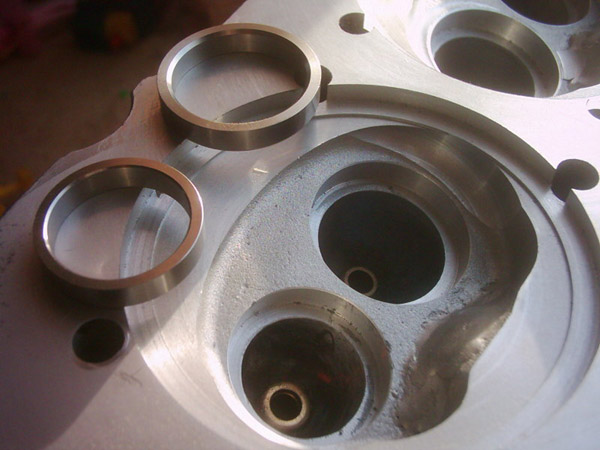
Posted by: Mark Henry Oct 28 2016, 01:23 AM
Some head work I posted way back when this site started.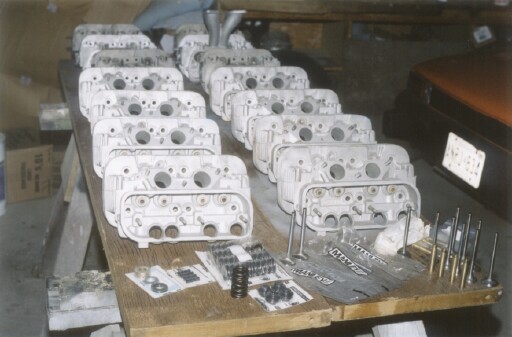
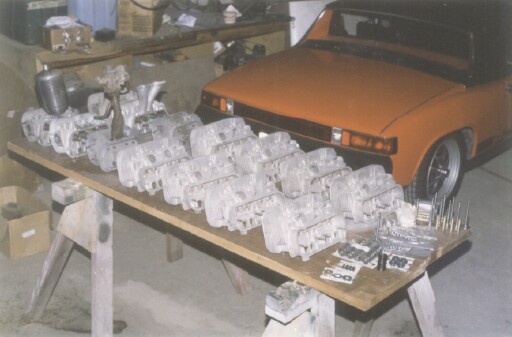
Posted by: KeithVonLaws Oct 28 2016, 02:23 AM
My personal engine, 102mm X 78mm, nickies with JE pistons.
Built the heads myself, 12mm plugs, 44mm X 38mm SS valves 8mm stems, new seats, dual springs , CrMo retainers, hardened keepers, shimmed, bit of exhaust porting 9mm X 8mm exhaust studs, bored to 103 register, 9.2 CR.
No head gaskets, nothing really trick about the sealing surface....
I have about 20K on the engine now, my summer DD.
Nice Work Mark,
I love the smaller 12mm plug work. Thats also part of my plan.
I also see that you unshrouded the valves quite a bit. Do you
do anything special when installing your valve seats ? (Thermally)
Such as warming the heads and chilling the seats before installing
them ? Most of my experience has been in the Diesel world or old
school Small Block Chevrolet stuff....
Thanks Keith
Posted by: injunmort Oct 28 2016, 04:40 AM
"nothing really trick" of the four engines sitting om my bench, none of them look like that when i tear them down. those heads all look refreshed, and newly machined. new valve seats new valves, fly cut,new guides, etc. really?
Posted by: N_Jay Oct 28 2016, 07:24 AM
The problem with those heads pictured was not that the gasket failed, it is that they were run long after the gasket failed.
Posted by: Mark Henry Oct 28 2016, 07:48 AM
"nothing really trick" of the four engines sitting om my bench, none of them look like that when i tear them down. those heads all look refreshed, and newly machined. new valve seats new valves, fly cut,new guides, etc. really?
Yes really.
The "nothing really trick" comment is about the sealing surface just being machined flat and no head gasket.
As far as Len's heads being expensive...quality costs. I've used Len's heads a few times, very high quality work and worth every penny.
Needless to say I know exactly what goes into building a set of HAM heads.
Nice Work Mark,
Do you do anything special when installing your valve seats ? (Thermally)
Such as warming the heads and chilling the seats before installing
them ?
Thanks.
I warm the heads a bit and cool them slowly. I've tried freezing the seats, but by the time I get my poop in a group they're warm anyways.
Good eye on unshrouding the valves.
Posted by: mbseto Oct 28 2016, 08:31 AM
Tried to find that discussion mentioned upthread. Not sure if it was one of these, but here are some pull quotes for historical perspective...
2009: http://www.914world.com/bbs2/index.php?showtopic=99426
QUOTE(brandomc @ Sep 16 2009, 04:21 PM) *
QUOTE(aircooledtechguy @ Sep 16 2009, 04:13 PM) *
These gaskets PROMOTE leaks and should NOT be used.
Thanks for the info, that sounds like a good solution. Does everybody else agree?
I DO NOT agree. 36 Years of T4 experience, all of it professionally, tells me you need to use/keep the head gaskets on a stockish 1.7. If you choose to delete them, be sure to calculate and shim the cylinders to make up for the increased compression, something you DO NOT want, especially with the fuel we get today...... If you have erosion on either the cylinders or the heads, you'll need to replace the pistons and cylinders or surface the heads, which ever is appropriate, and shim the cylinders to compensate for the material removed. DO NOT lap the cylinders into the heads. Your eyes and arms DO NOT constitute a vertical milling machine, and they're not gonna maintain the tolerances. You will need head gaskets, pushrod tube gaskets, exhaust gaskets, valve cover gaskets, and intake insulator/gaskets.
The Cap'n
http://www.914world.com/bbs2/index.php?showtopic=113219
Nice (sick) photo of a failure.
2011: http://www.914world.com/bbs2/index.php?showtopic=145983
QUOTE(larss @ Sep 29 2011, 06:48 AM) *
If I don't fit any gasket at the top of the cylinders (which is what every expert suggests) will this affect the type/thickness of shim used at the bottom or is the increase in compression so marginal that standard shims can be used?
/Lars
"Every expert suggests"? What, I'm no expert, despite my 38 years of T4 engine building? I use them and I've never had a problem.
The Cap'n
You obviously don't know, because you couldn't find the technical bulletin, that the delete applies ONLY to the 2 liter busses with the modified replacement cylinder heads. It doesn't apply to the original heads, nor to the 1.7/1.8 engines, nor to the 2.0 Porsche engine. The internet is filled with people who mention the document but have failed to either read or understand it. Lotsa cases like that, and not just in the car related sites. People hear things and repeat them as if they were true. Jake, among others, leaves the gaskets out, and I'm fine with that. He has the R&D and practical experience to do that, and he has the ability to prepare ALL the necessary surfaces in order to do it right, and not to just leave them out. FWIW, if your heads are not new and untouched, the CC volume isn't going to be "standard". Surfacing the head changes the CC volume, and the amount of change depends on the depth and the number of times it's been done.
The Cap'n
2014: http://www.914world.com/bbs2/index.php?showtopic=245617
If you're willing to put the kind of basic prep work into your engine that Jake does, the absence of head gaskets is probably not going to be a bad thing. How many folks here have the cases checked for warpage, and corrected both at the bore AND the deck? People on this forum complain about the cost of a rebuild, and they don't even do a proper "remanufacture". Most just do the minimum and forget it until something fails prematurely. Not so Jake, and not so me.
The Cap'n
there ARE times when a head gasket is a good idea. When you have questionable machining from a flycut, for example, and lapping won't be enough. Or when have no other way to get deck height, are building a performance engine that will be torn down frequently, things like that. Or even when you just damned well want to
DBCooper
The point that everyone here seems to have missed is VW redesigned the cylinder heads. The Spanish heads are of the redesigned variety. When that happened, the head gaskets were no longer necessary. They DO NOT tell you to leave out the head gaskets on engines not of the specified series. Note, too, that the 914 2.0 is a VW "BASED" engine, and the pistons, cylinders, and heads are different from the 2.0 VW engine.
The Cap'n
Posted by: DBCooper Oct 28 2016, 10:44 AM
The point that everyone here seems to have missed is VW redesigned the cylinder heads. The Spanish heads are of the redesigned variety. When that happened, the head gaskets were no longer necessary. They DO NOT tell you to leave out the head gaskets on engines not of the specified series. Note, too, that the 914 2.0 is a VW "BASED" engine, and the pistons, cylinders, and heads are different from the 2.0 VW engine.
The Cap'n
I have infinite respect for the Cap'n, but there were times when he was.... um... mistaken. That statement "the 914 2.0 is a VW "BASED" engine, and the pistons, cylinders, and heads are different from the 2.0 VW engine" isn't correct. What we're talking about is the sealing surface, method, materials and dimensions, which is exactly the same in all the VW and 914 1.7, 1.8, and 2.0 engines. The AMC heads step may be different, but not the sealing of the OEM cylinders and heads, they're all the same. That's not an opinion, it's not subjective, you can verify it yourself. Please do, go out in the shop and measure, and if you find any difference then PLEASE point it out.
There's a bigger problem though. You're a professional, you've built how many T4 engines? 10? 20? >50? And they've all turned out well? Great, you've fulfilled your responsibility to your customers, so good job. But with that in mind take a look at those VW engineers. They're responsible for how many engines? Hundreds of thousands? Do you think management let them wing it? Or did they make that technical U-turn after ten years of experience, reviewing piles of histories and empirical evidence? I'm betting they had a lot of very good reasons to issue that bulletin.
Now the dilemma. You've never had a problem with head gaskets? Great, and that's a perfectly reasonable justification to keep on using them. What you do in your shop is one thing, but the problem is that making the statement here, that gaskets should be used, also means you're saying VW engineers are wrong. Can you do that? State that VW is wrong? And substantiate it?
Look, reality is that gasket failure rates are pretty low, so this isn't life and death. To the original question I'd also say to go ahead and re-assemble the engine with new head gaskets and run it. It was just built, and assuming it was done well then that should be fine. No need to be inflexible, but could I suggest something? If you've always used gaskets why not experiment with leaving them out? It obviously works for others, and it's VW's advice, so why not try something new, take a chance? You don't want to be that old guy cursing fuel injection and shouting at clouds, do you? So try it. It won't hurt, and you might like it.
So everybody's right! Now back to being one big, happy family!
Posted by: N_Jay Oct 28 2016, 11:17 AM
This has ben fun and educational.
Thanks to those with the experience to lend.
OK, who wants to go in a engine with a machined grove for an o-ring sealing gasket?
The best of both worlds. Cylinder to head contact AND a crush seal?
Posted by: 914_teener Oct 28 2016, 11:47 AM
This has ben fun and educational.
Thanks to those with the experience to lend.
OK, who wants to go in a engine with a machined grove for an o-ring sealing gasket?
The best of both worlds. Cylinder to head contact AND a crush seal?
Well....I'll put my engineer hat on and my experience to add:
Point of failure, especially critical to failure. Ask the Morton Thiokol engineers what they think about O rings. There is really no argument here, it really depends on the conditions and the failure mode...how many of them are critical. Economic viability drove them to engineer the O ring solution. If money weren't an object...it wouldn't have been there.
When they identified the failure point (32 degrees) politics and money took precedence over the engineers.
In context to our passed friend John Larson whom I had to pleasure of meeting on several occasions I'll share a story and if some of you have heard this one before please indulge me a little.
One of the last things he built was my spare transmission before he passed. I was with him in his garage while we were fitting the nose cone on and the shift lever cover has a small little O ring where it fits into the case. He took GREAT pains to make sure it was clean...seated properly...and wasn't pinched at all. It was a pleasure to watch him work. I asked him why most people put silicone in there and he replied:
"...because most people don't know what the phuck they are doing and it makes them feel better".
So if it makes you feel better, use gaskets. But know there is a risk to failure.
Maybe there is a life lesson here about feeling good and doing good.....maybe?
Posted by: Mark Henry Oct 28 2016, 12:03 PM
Yep if want to use a gasket on a stock engine go for it.
But, if you are using 96mm I'd think hard on the subject. You will be leaving 1mm hanging out in the chamber, not hard to imagine it will deform slightly when torqued, lifting off the head. You are now introducing a sharp edge (hot spot) inside your chamber.
I have a hard time with the "the bulletin was meant only for VW busses" argument, VW was having issues with the lower CR bus engine, but that doesn't apply to a higher CR 914 engine? ![]()
As far as engineers go VW/ Porsche is excellent, but not infallible. I guess pulled and broken head studs, head cracks, oil leaks, IMS, D-chunk, etc. are just figments of our imagination.
Food for thought, VW engineers told Porsche engineers that they couldn't stroke out a T4 to 2.0, 4 years later VW started putting 2.0 into busses.
I have nothing but respect for the Crusty one, on this this subject we had a agree to disagree arrangement. We talked many times by PM, he spent a fair bit of time explaining a step-by-step timing belt/water pump repair when I did it on my passat.
We just never discussed head gaskets. ![]()
Posted by: N_Jay Oct 28 2016, 12:37 PM
I have to agree with you on one point, you DEFINELT don't want the gasket protruding into the combustion chamber.
Now I am scratching my head (no pun intended) as to what I did with my 2.4 when I built it.
I guess I will get a reminder when I pull the heads (due to a broken exhaust valve spring)
Posted by: stevegm Oct 28 2016, 12:48 PM
Yep if want to use a gasket on a stock engine go for it.
But, if you are using 96mm I'd think hard on the subject. You will be leaving 1mm hanging out in the chamber, not hard to imagine it will deform slightly when torqued, lifting off the head. You are now introducing a sharp edge (hot spot) inside your chamber.
I have a hard time with the "the bulletin was meant only for VW busses" argument, VW was having issues with the lower CR bus engine, but that doesn't apply to a higher CR 914 engine?
As far as engineers go VW/ Porsche is excellent, but not infallible. I guess pulled and broken head studs, head cracks, oil leaks, IMS, D-chunk, etc. are just figments of our imagination.
Food for thought, VW engineers told Porsche engineers that they couldn't stroke out a T4 to 2.0, 4 years later VW started putting 2.0 into busses.
I have nothing but respect for the Crusty one, on this this subject we had a agree to disagree arrangement. We talked many times by PM, he spent a fair bit of time explaining a step-by-step timing belt/water pump repair when I did it on my passat.
We just never discussed head gaskets.
Interesting. Yes, I am using 96mm P&C. The more I learn, the less I know. I assume nobody makes a head gasket that is designed to use on the 2.0 liter head with 96mm P&C?
Posted by: DBCooper Oct 28 2016, 12:48 PM
"...because most people don't know what the phuck they are doing and it makes them feel better".
Ha ha, that's hilarious. I never met him but can see him saying that, clear as a bell. Good guy. And krusty.
Posted by: N_Jay Oct 28 2016, 01:10 PM
Hey! Hay!
I know all about the famous o-ring failure. (What type of seal would you have suggested?
That aside, I was thinking more along the lines of a annealed aluminum or copper ring, not a silicon rubber one.
All in all, just engineers daydreams.
Still wonder, why the head bolt torque is not adjusted up or down based on the surface area of the cylinder to head seal? Hmmmm?
Seems the clamping force in PSI is what you want to control?
Posted by: KeithVonLaws Oct 28 2016, 03:24 PM
I bet more failures occur due to Pre-ignition or detonation from poor tuning or other build mistakes like Mark's reference to the 96mm gasket overhang/hotspot.
Its plainly obvious clamping issues and surface finishes make a difference.
Besides clamp load - bore distortion and surface finishes and all the usual
hurdles we have to look at for a racing engine.....If your building a mild street application I would lean to focusing on proper build techniques attention to small details..... Lap the head to the cylinders... measure and equalize everything
and use proper tuning .
In my case Personally, I would like to see for myself if I can build a
reliable 250 hp Type IV engine for track day events and some limited road driving for under $6000.00 - Thats my goal...pretty lofty I know. I am slowly getting my components together.
Posted by: Mueller Oct 28 2016, 03:32 PM
Hey! Hay!
I know all about the famous o-ring failure. (What type of seal would you have suggested?
That aside, I was thinking more along the lines of a annealed aluminum or copper ring, not a silicon rubber one.
All in all, just engineers daydreams.
Still wonder, why the head bolt torque is not adjusted up or down based on the surface area of the cylinder to head seal? Hmmmm?
Seems the clamping force in PSI is what you want to control?
Not enough room for a ring on the top of the cylinder to be reliable.It can and has been done, just not as reliable as the 2 proven methods in this thread. I'm going the method Jake and Len recommend, if I change my mind and decide factory method only, I might as well throw away my 205/50-15 tires for the 4 lug Mahles I want since Porsche never installed that size tire!
Heck, I should toss those SSI heat exchangers since surely Porsche wanted carbon steel only
Posted by: Mark Henry Oct 29 2016, 08:30 AM
In my case Personally, I would like to see for myself if I can build a
reliable 250 hp Type IV engine for track day events and some limited road driving for under $6000.00 - Thats my goal...pretty lofty I know. I am slowly getting my components together.
Well that's a topic for another thread, but I'd say no to the 250hp. You're expecting too much from a pushrod engine based on a 90 year old design.
I have well over $8K in parts into my long block alone, count my EFI and exhaust close to $12K for 180hp.
That's just in parts.
If 250hp is your goal I'd forget about the T4 and /6 and go straight to a V8. Even then your budget might be a tad light.
Posted by: DBCooper Oct 29 2016, 08:44 AM
In my case Personally, I would like to see for myself if I can build a
reliable 250 hp Type IV engine for track day events and some limited road driving for under $6000.00 - Thats my goal...pretty lofty I know. I am slowly getting my components together.
Well that's a topic for another thread, but I'd say no to the 250hp. You're expecting too much from a pushrod engine based on a 90 year old design.
I have well over $8K in parts into my long block alone, count my EFI and exhaust close to $12K for 180hp.
That's just in parts.
If 250hp is your goal I'd forget about the T4 and /6 and go straight to a V8. Even then your budget might be a tad light.
You could do that, or go turbo Subaru, a half-ton lighter and still a flat four.
Posted by: Mark Henry Oct 29 2016, 01:06 PM
You could do that, or go turbo Subaru, a half-ton lighter and still a flat four.
I did think of posting that but Keith did say he had experience with american iron.
Posted by: DBCooper Oct 29 2016, 02:31 PM
And I almost didn't post it for fear of being too much of a Subaru fanboy. But hey, if it works....
Posted by: ClayPerrine Oct 29 2016, 04:14 PM
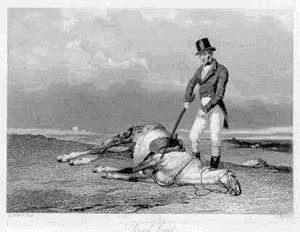
Posted by: Keyser Sose Oct 29 2016, 04:38 PM
I don't understand. If you don't like this thread then why do you keep coming back? Why not just skip it?
Posted by: injunmort Oct 29 2016, 06:07 PM
because we all like train wrecks, and i am a special kind of stupid
duh
Posted by: stugray Nov 14 2016, 11:37 AM
Ok, I stayed out of this conversation towards the end because I had just finished my last race of the year.
During that race I was hearing a loud "Brrrrrrrrrppppppp!!!" whenever I exceeded 6200 RPM.
I thought it was an exhaust leak, found one leak, fixed it, and the noise did not go away.
I was worried it was a head leak.
SO I decided to pull the motor at the end of the season and have a look.
First compression test just before pulling the motor was bad - 60-70 PSI cold, 75-80 PSI warm - Not good results.
So I pulled the engine Saturday and got the heads off yesterday.
This engine is a 9.5:1 CR and I routinely rev it above 6200 RPM during hard racing (20 minutes at a time).
During disassembly I DID find at least one exhaust leak between the stubs and the headers, so that was probably my "Brrrrp!!" noise.
I assembled this engine with no head gaskets jugs were brand new and heads had just been machined down to decrease comb chamber volume.
I did NOT hone these heads or do anything other than bolt them up.
When I took the engine apart I checked the torque on all the bolts and some were a little low (~20 ft-lbs).
I can detect ZERO leakage or blowby on the sealing surfaces.
My valves are a different story.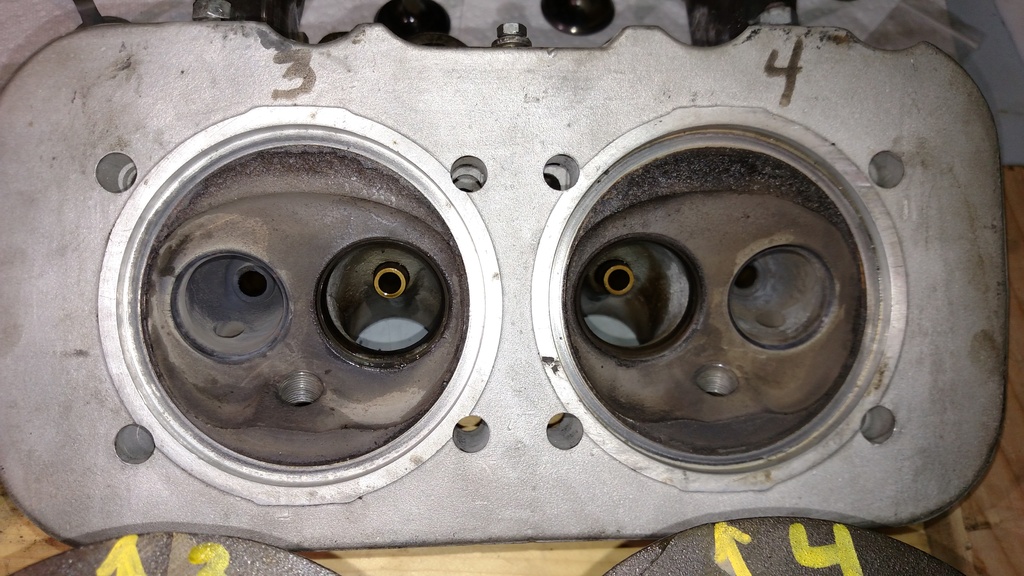
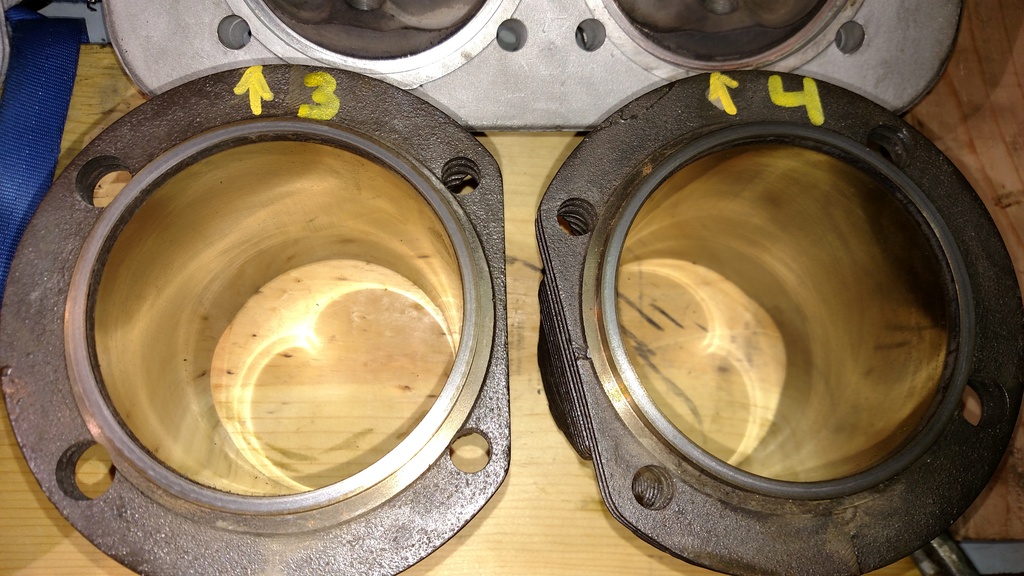
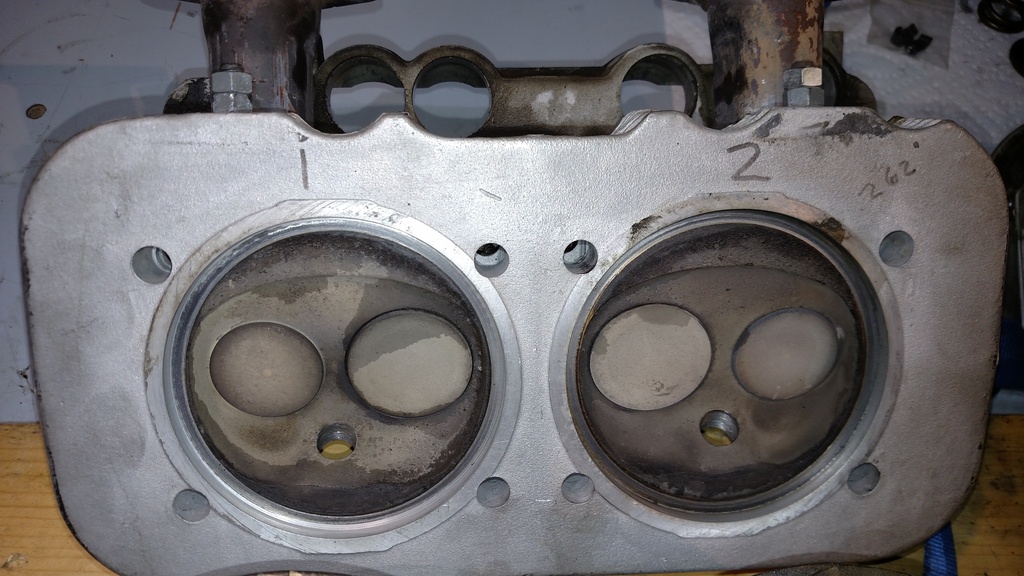
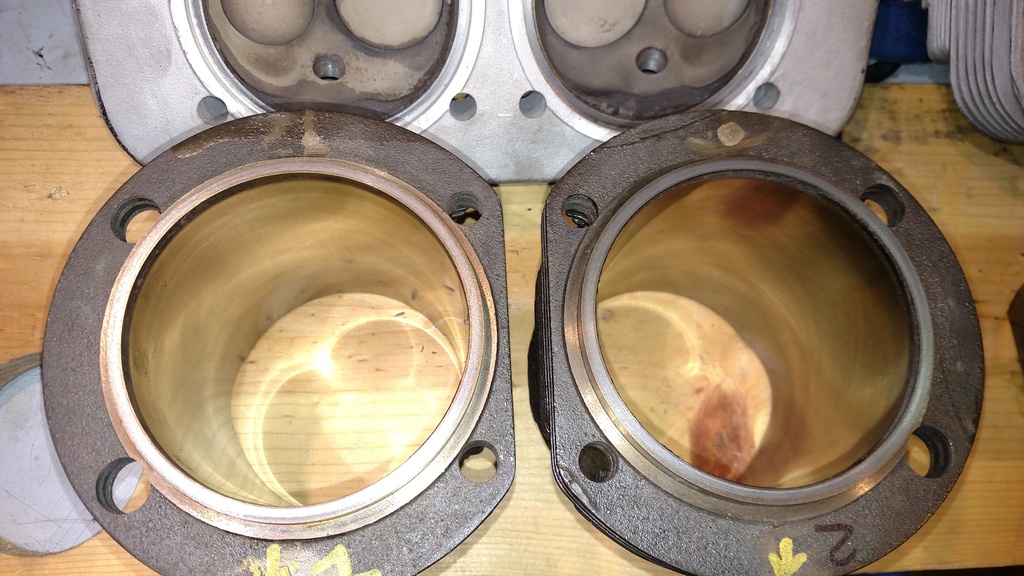
And here is my home made spring compressor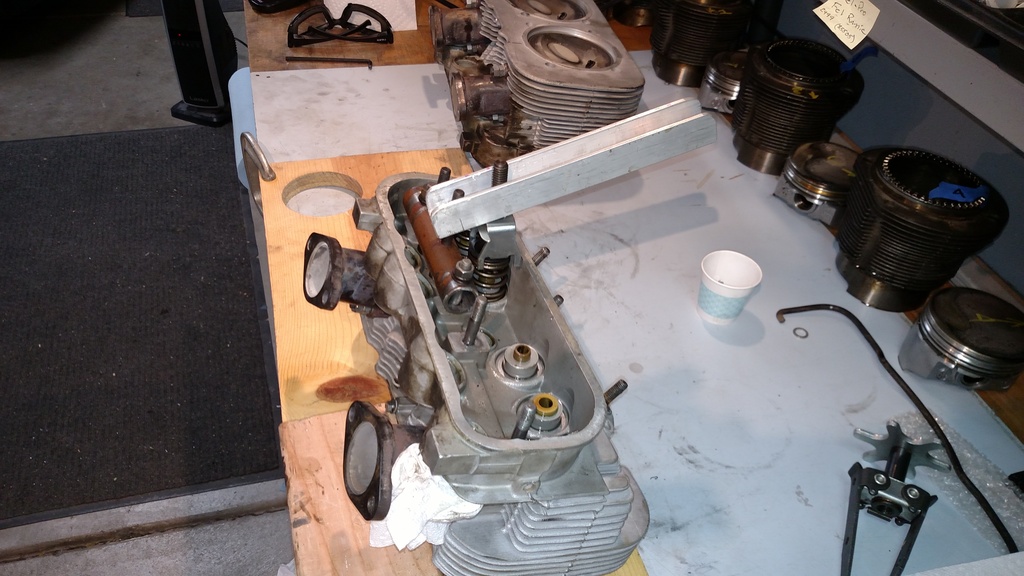
SO long story short: No head gaskets, no special prep (other than GOOD mating surfaces), normal torques, 9.5:1 CR and engine routinely reved above 6200 RPM.
No discernible leaks after 2 race seasons.
The engine looked like new inside.
So run head gaskets if you want, I dont, and I am fairly certain that I beat on this engine more than your average DD.
Posted by: Jake Raby Nov 14 2016, 12:36 PM
Hey! Hay!
I know all about the famous o-ring failure. (What type of seal would you have suggested?
That aside, I was thinking more along the lines of a annealed aluminum or copper ring, not a silicon rubber one.
All in all, just engineers daydreams.
Still wonder, why the head bolt torque is not adjusted up or down based on the surface area of the cylinder to head seal? Hmmmm?
Seems the clamping force in PSI is what you want to control?
Going up on head torque is the fastest way to create head leaks, with or without gaskets. Due to the non square stud pattern, and the two different lengths of head stud its pretty easy to tweak a head once its hot.
Posted by: stugray Nov 15 2016, 03:45 PM
Hey! Hay!
I know all about the famous o-ring failure. (What type of seal would you have suggested?
That aside, I was thinking more along the lines of a annealed aluminum or copper ring, not a silicon rubber one.
All in all, just engineers daydreams.
Still wonder, why the head bolt torque is not adjusted up or down based on the surface area of the cylinder to head seal? Hmmmm?
Seems the clamping force in PSI is what you want to control?
Going up on head torque is the fastest way to create head leaks, with or without gaskets. Due to the non square stud pattern, and the two different lengths of head stud its pretty easy to tweak a head once its hot.
So what is the consensus on retorquing the head nuts on the type-IV after X miles?
IIRC for the type-I it was required.
On these engines it is much more difficult with half the nuts behind the shrouds.
Seems that at lest one of mine was below 18 ft-lbs when disassembling.
I am fairly certain that I used exactly the specified torque of 23 ft-lbs using the proper pattern during assembly.
Too bad there's no easy way to assemble the long block and put it in an oven overnight at ~280 deg F then retorque after cooling.
Posted by: stugray Nov 17 2016, 12:56 PM
Just for future reference:
Gasket failure:
No Gasket - No failure:
(NOTE 9.5:1 race motor run at 6200 RPM consistently):

Shit:
Shinola: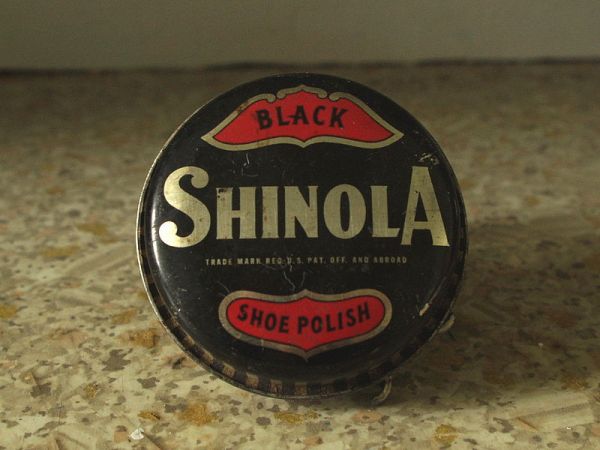
Just thought I'd clear that up
Posted by: Mark Henry Nov 17 2016, 01:05 PM
Shit:

Shinola:

Can you imagine what it was like being a Shinola salesman?
Posted by: stugray Nov 17 2016, 04:37 PM
Shit:

Shinola:

Can you imagine what it was like being a Shinola salesman?
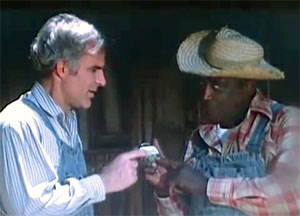
Posted by: Marty Yeoman Aug 22 2017, 04:09 PM
I just read thru this thread. Very illuminating. Here is my situation and probable solution. I thought I'd throw this out there for others to comment on. I'm putting together a 2056 build. I have a set of 2.0 liter heads that have been resurfaced at the cylinder sealing plane. The problem is that the plane is now too deep in the head to provide clearance for the cylinder spud. In other words the sealing surfaces don't contact. I could fill the gap (>1mm) by using a head gasket but would rather not. I prefer to flycut the heads to remove what I consider excess material and go with no gasket at the head. I would still use the shims below the cylinder to control deck height and compression ratio. Currently, I calculate the no gasket senerio at about 9:1. This motor is going into my daily driver and is going to run L-Jet using a WebCam-73.
Thanks for commenting.
Attached image(s)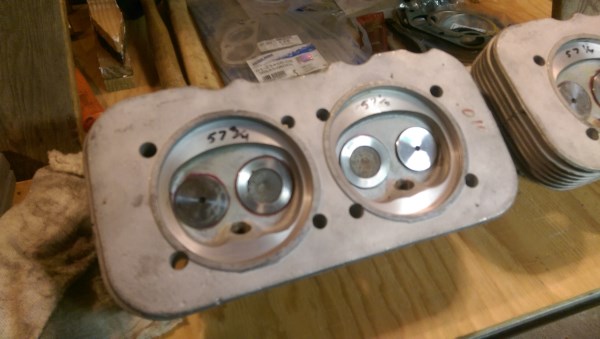
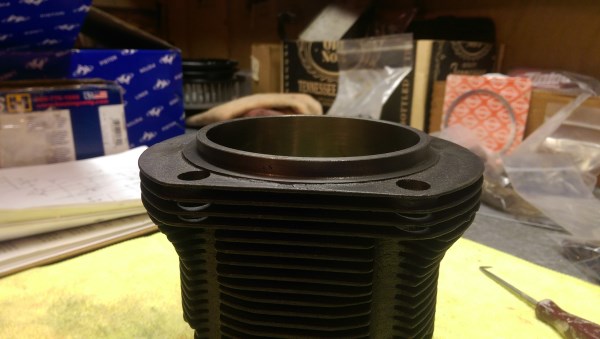
Posted by: worn Aug 22 2017, 06:06 PM
Happened to me when I resurfaced the sealing circle, for lack of a better term. The cooling fing portion of the cylinders, spud as you say, was then too close. So I got out the fly cutter and trimmed the faces of the heads. Well described in the Wilson book.
Posted by: boxsterfan Aug 22 2017, 06:10 PM
I think we should have a "Gaskets vs No-Gaskets" softball game to settle this debate once and for all.
Powered by Invision Power Board (http://www.invisionboard.com)
© Invision Power Services (http://www.invisionpower.com)
